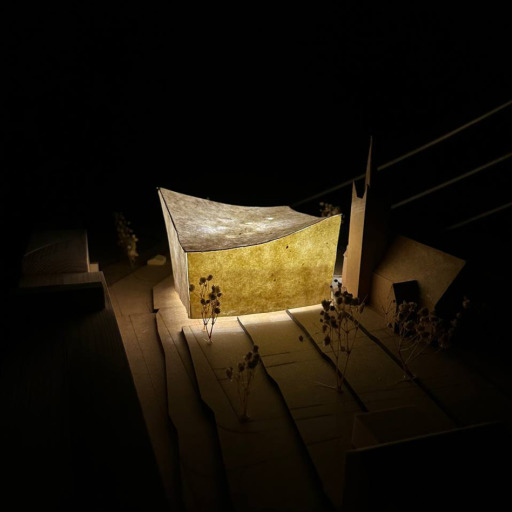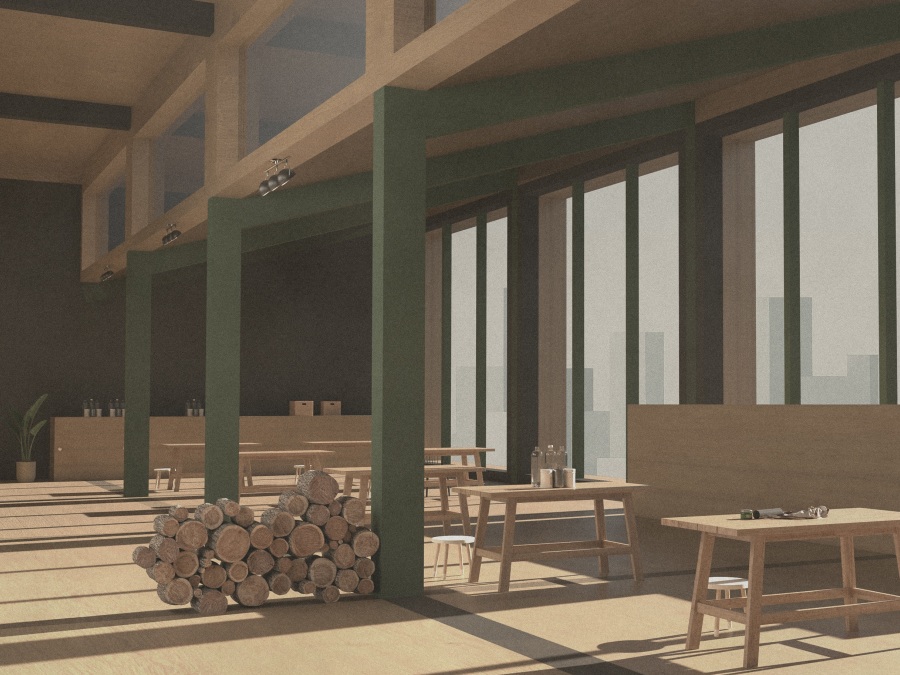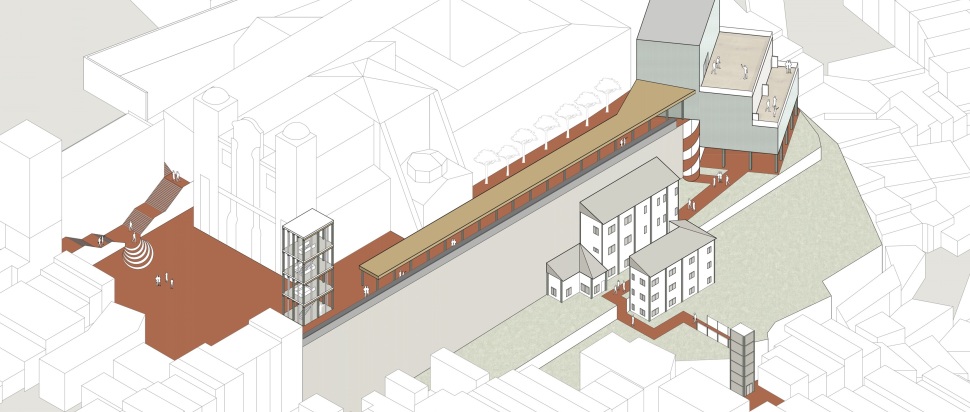GSA Degree Show 2025: Architecture
This year’s Mackintosh School of Architecture showcase presents a glimpse into the responsibilities future architects must inhabit, through teachings of ecology and sustainability
In a time of heightened awareness of the climate crisis, social injustice and political instability, there has never been a more critical time to examine the civic role of architecture. The students’ work in this year's Mackintosh School of Architecture showcase displays an innate understanding of architectural accountability, one that confronts the past to create for the future.
In understanding the complicated histories and surroundings of their assigned sites, this year’s graduates have translated the social and environmental concerns and placed community at the heart of design in shaping their proposals. Through drawings, renders and models, the Bourdon Building is transformed not just into an organised display, but most importantly, into a space to envision a more hopeful future.
The Stage 3 showcase offers an introspective outlook on the Scottish Highlands by raising awareness about its political and social landscape through careful and innovative design. Hidden histories are exposed upon closer inspection, and in combination with a calculated choice of materials, the students of Stage 3 put forward their critical perspectives.
Noah Alexander-Cairns’ project, A Memorial to a Sunken Village, brings to light the history of the Highland Clearances and the submerged ruins of a once-thriving community in his proposal for an observatory near the Lochaber hydroelectric scheme. Every aspect of the design process is steeped in politics, as even the path that leads to the observatory follows the history of the forgotten community and old roads that once existed. The observatory is a memorial to the forgotten Highland community on whose land the dam is situated now, but also to the Irish workers who lost their lives in constructing the hydroelectric scheme. With the use of recycled burnt timber to mimic the arrangement of the forest, the observatory creates a confinement of space for the viewer as they look outward to the open loch, which in turn inhabits the conversations of the present about the exploitation of the Scottish waters. With sustainability at the heart of creation, protection of histories as inspiration and careful attentiveness to the surrounding landscape, Noah envisions a seafront structure that is as in touch with the people as it is with the landscape, thereby bridging its hidden history to the present.

Lifelong Learning Retreat, MSA Stage 3, Jennifer Lyall
Jennifer Lyall’s Lifelong Learning Retreat seeks to reintroduce the history of the Scottish Highlands’ paper industry that revived the landscape in and around Fort William. There is a delicate balance between educational and aesthetic purposes, playing with the site's public and private surroundings, situated between a quiet burial ground and a public promenade. Juxtaposition underpins Lyall’s intricate design, aiming to bond together both old and young, locals and tourists. With a focus on handmade paper, Lyall attended various workshops learning about this unique process. The space reflects this intimate and personal way of learning and presents itself as a heritage site, where these resources are to be preserved. Perforated aluminium coats the building in a double-skinned façade, echoing the appearance of a paper lantern – it becomes a beacon of light. Embracing the natural climate, a curved roof acts as an inverted umbrella. In turn, the rainwater flows into a central feature that runs through the building, adding to the tranquil experience and opening conversations about recyclability.
In line with the principles of connecting people to the impressive landscape of the Highlands, Alanya Price’s project Hydro-Pipes brings light to the Lochaber tunnels hidden beneath the mountains. Sitting right above the pressure tunnel hidden away by the natural landscape, Price’s design replicates the scale and feeling of being inside the pipe, emulating the claustrophobic experience of the workers involved in the construction of the hydropower scheme. The small sections of pipes not only follow the 15-mile-long journey of the pressure tunnel beneath Ben Nevis, but also serve as a purposeful sensory experience for tourists and locals who stumble upon it. With each concrete pipe standing at a different angle and different patterns of holes cut into them, viewers can feel natural light and wind in a concentrated and unfamiliar way.
Moving from the challenges of the natural landscape to the urban, this year’s Stage 4 students showcase a collection of architectural projects that push the boundaries of conventional design, weaving together social, political and artistic movements, and considering how these themes sit within the city’s structure. This year, the students consider how they can revive the cultural landscape in Glasgow, developing archival institutions in today’s contemporary world.
Anthony Di Gaetano’s The Glasgow Film Institute is an extension of Film City Govan, a film production company based in Glasgow. Anthony invites us into a lively social hub, where film as a storytelling medium is at the forefront of his design. In view from Central Station, the building is Glasgow’s cultural values immortalised. Confronted with an impressive, animated exterior, prolific film stills etched onto glass panels envelope the entire façade, drawing us into a spatial experience. Exposed cross-laminated timber, cork insulation and recycled steel run throughout the building, bridging together the industrial feel of Glasgow as a city and the intimate engagement with film. Adaptability at the core, there is the potential for a rolling programme via extendable and foldable walls, platforming stories that aren’t always told and creating a unified arts space.

The Wood Institute, Glasgow Wood, MSA Stage 4, Ayça Zembat
In working with the confines of the city centre, Ayça Zembat’s project combines the needs of her client, in creating a commercial building, with what is needed by the community of Glasgow. Using recycled timber, which mirrors the ethics of her client, Glasgow Wood, the five-storey design houses community-driven initiatives such as a gallery space, library and workshops. Ayça’s design is inherently founded on sustainability, but also openness, bringing the public in and recognising initiatives that make the city lively and active. In direct contrast to the shielded tenement buildings found in the city centre, Ayça’s design of the façade exudes warmth, with big, wide windows evoking intrigue in those who pass the building. These designs make any viewer wonder what other changes could be made or added to Glasgow’s landscape to improve the livelihoods of those who inhabit it.
Such ethics behind building within an established city is a growing concern amongst architects, and one that is presented by the Stage 5 showcase as they tackle these understandings in their project, The Ethical City, set in Porto, Portugal.
Margaret Harvie’s Civic Sanctuary reframes the city structure of Porto with the Jesuit Church as its backdrop. Marrying together religion, community and education, it offers a safe space for poverty-stricken communities. The carefully considered design integrates well into the crowded multi-level infrastructure of the city, actively engaging with ideas of intra-activity where the structure feels as though it emerges through the interconnectedness of the surrounding environment. Glue-laminated timber and polycarbonate materials encompass the façade, with different opacities and tectonic light features dotted across the myriad of spaces, creating a warm and inviting atmosphere. Porosity and openness emanate through the combinations of outdoor/indoor architecture, showcasing a chapel space, emergency accommodation, a dining hall and an educational centre forming the shape of an outstretched arm. Reconstructing our preconceptions of the church through a 21st-century lens, Harvie’s design reimagines the contemporary cultural landscape of Porto.
A distinct architectural shift is exhibited, displaying a new hopeful recognition of the architects’ impact on the climate and giving us a sneak preview into powerful and innovative visions of the future as they move beyond the Degree Show.
The Mackintosh School of Architecture Degree Show, Bourdon Building, 30 May-8 Jun
